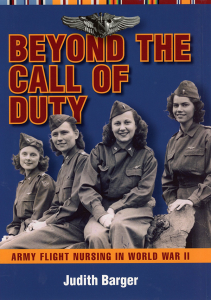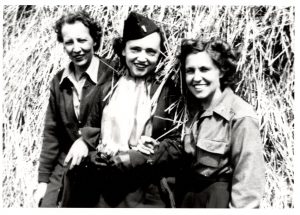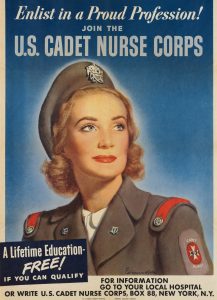The Twenty–ninth in a series of Blogs about the 31 Medical Air Evacuation
Transport Squadrons activated during WW2
to provide inflight nursing care to sick and wounded soldiers,
tended by Army flight nurses and enlisted technicians.
The focus is on the flight nurses.
Interlude: Social Life
After 2 flight nurses recently had married and were transferring from their base in England back to the US in February 1945, the squadron historian for the 817 MAES quipped that chief nurse Dorothy Berendsen “had better guard her brood more zealously against Dan Cupid’s ravages”. 1
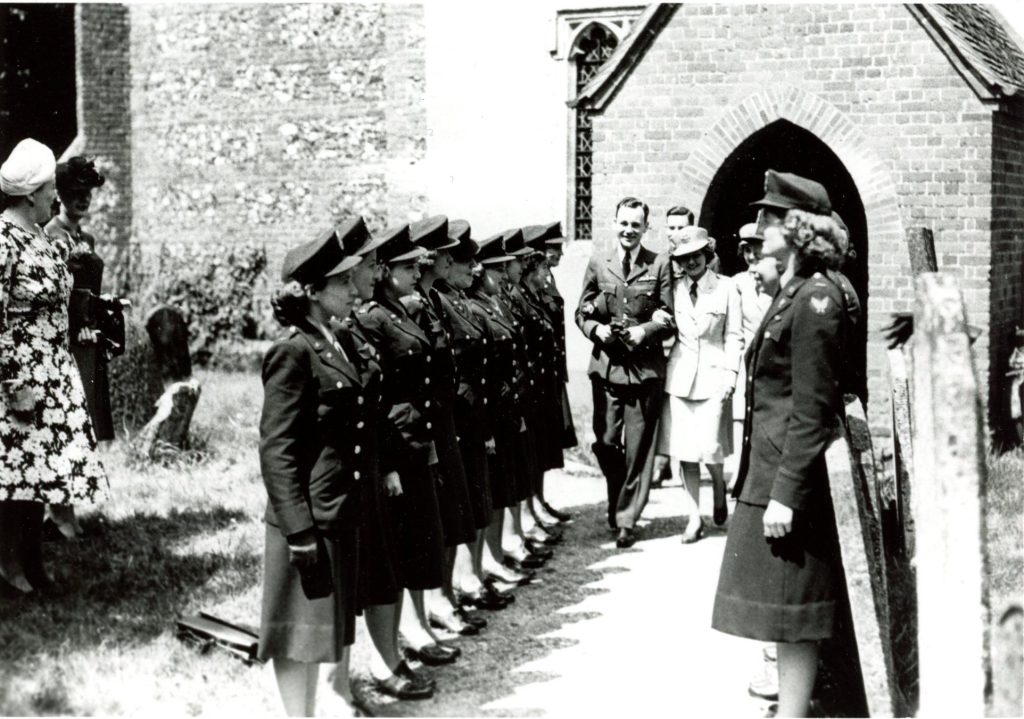
Military Wedding, Boxford Church, England
(Author’s Collection)
“The Feminine Side” that flight nurses Nancy Preston and Ada Endres contributed to their squadron history in August 1944, suggests that Cupid was active in the Pacific as well. The flight nurses were aware that their presence among so many men caused a stir:
The great breach between supply and demand frequently leads to minor holocaust and occasionally we become weary of our popularity. Life goes on, however, and let no man fool himself with the mistaken thought that the eternal search is not going on right before his nose, war and weariness notwithstanding. We are to the last one of us good wholesome girls with a bird in the hand and an eye to the future – and there are some few fortunate among us who have the bird by the beak. 2
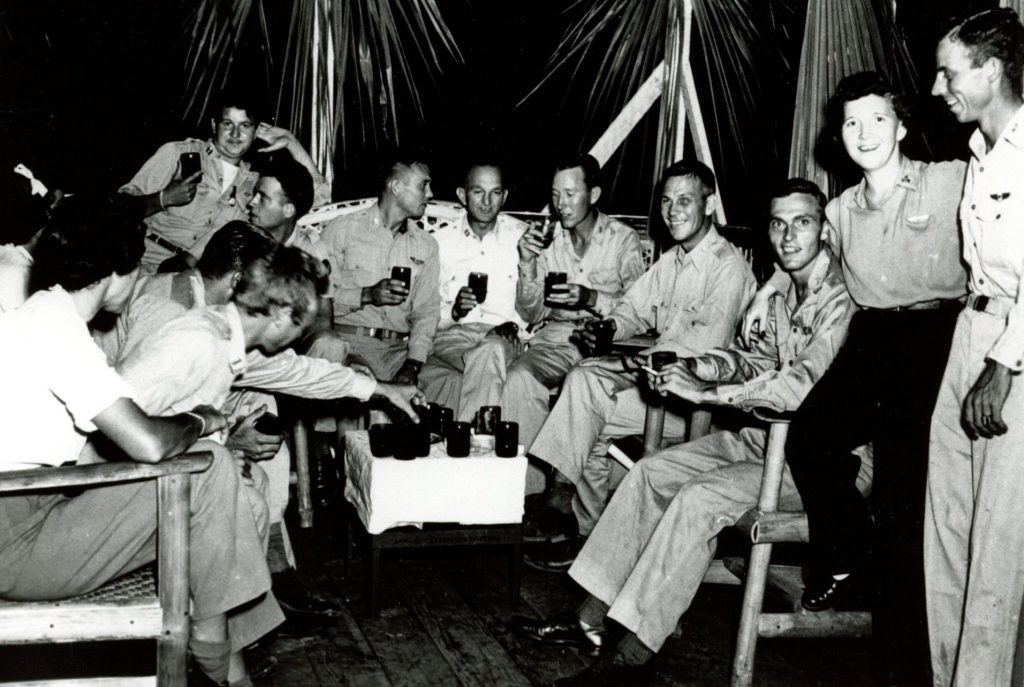
Social gathering in the Philippines, 1945; 801 MAES
Mary Wiggins is 2nd from right (Author’s Collection)
“Dating, of course, is no problem in N.G. [New Guinea],” Dorothy Rice of the 804 MAETS wrote to Leora Stroup at the School of Air Evacuation, Bowman Field, KY. “One could find themselves in a continuous whirl if one only had the energy and endurance, but to keep working steadily in this N.G. heat one needs plenty of rest. It is an absolute must in our squadron – any flight except the very shortest – in bed by 10:00 pm.” 3
Chief nurse Elizabeth Pukas, who had 10 weddings overseas, took her role as surrogate “mother of the bride” very seriously when a flight nurse of the 812 MAETS became engaged. She hosted a dinner at which to meet the prospective groom, arranged leave for the prospective bride, and, if necessary, found a place for the couple to spend their short honeymoon. “[O]ur weddings were beautiful,” she said.
I had the complete cooperation of the Air Force and the Navy and the medical contingency whenever my nurses got engaged. Yes, you pulled strings – you have to. These are very important people. … The very next flight that goes to Hamilton Air Force Base, please allow my nurse who is going to be married to go to the continent to talk to her parents. Have them meet her, get her trousseau, so that when she returns, I’m going to be the mother for the wedding, for the reception, for the whole thing. I am a surrogate mother. 4
In what may have been a first in Hollandia, the 820 MAES turned its guest house into a bridal suite to accommodate a WAC and her new husband when no other place was found for them to stay. “The request was indeed unusual and unexpected but after some consideration, we all felt that the 820th could hardly fail at such a crucial moment,” the squadron historian reported, adding, “the wedding cake was excellent”. 5
Not all social gatherings resulted in weddings – some were official with required attendance. Flight nurse Jo Nabors, whose 812 MAETS recently had arrived at Hickam Field, Oahu, had gotten to her quarters late at night and was tired the next day. She continues the story:
And I got this phone call, and I was half asleep, and it said that we were invited to Colonel Smith’s afternoon tea, that he would like to meet all the new flight nurses. And I thought, Well, fine. I said, “Well, we’ll come over later,” – or something to that extent. And I went back to sleep. Well, the next thing I knew, somebody was knocking on our door and telling us did we not know that we [Nabors and her roommate] were invited to – And I said, “Yes, but we just didn’t feel like going.” She said, “Well, it wasn’t an invitation. It’s a command performance. You must go to this.” And I thought, Oh, my. So then they said we had to get dressed in full uniform with our caps and all and make an appearance, which we did. 6
Other social events were more enjoyable. Most MAETS marked anniversaries with a lavish party. The 801 MAETS was on Guadalcanal for its second anniversary as an outgrowth of the 38th Medical Air Ambulance Squadron activated at Fort Benning, GA in May 1942.
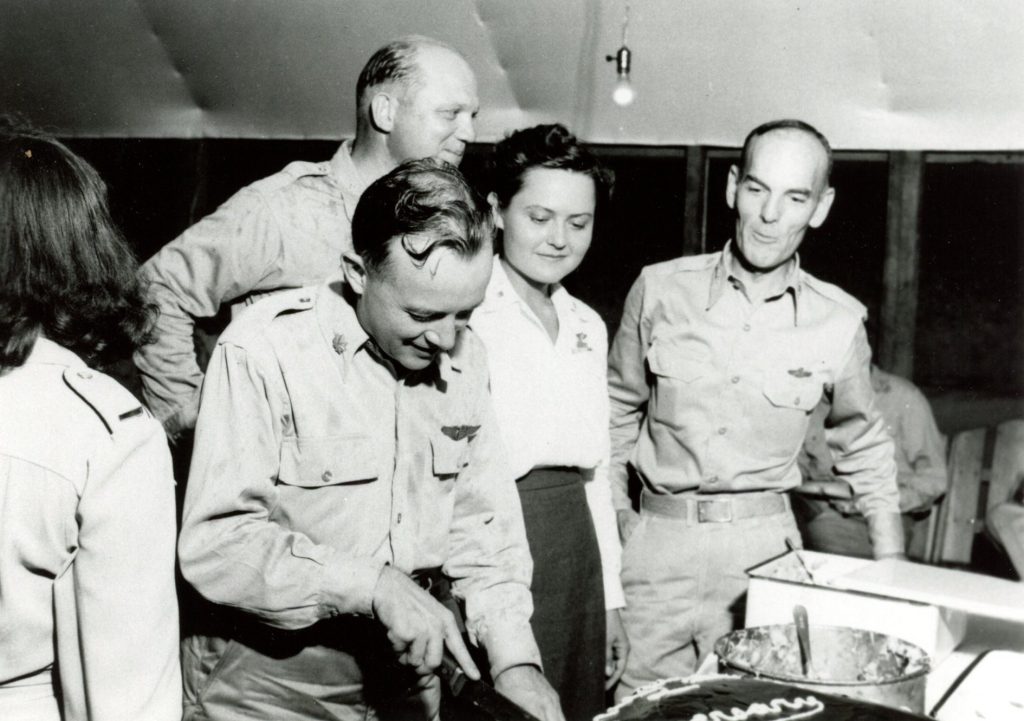
801 MAETS chief nurse Lucy Wilson at Anniversary Party,
Guadalcanal, May 1944 (USAF Photo)
Squadron parties ranged from pig roasts to sit–down dinners to formal dances. The flight nurses of the 801 MAETS knew how to persuade others to help them organize social events. Unit historian Wilbur Smith saw through their wiles, however, in a monthly report:
On the night of 29 June 1944, the Nurses gave a party. From small beginnings they wheedled the unsuspecting lieutenant until he worked day and night for them. He is much wiser now, but he has yet to learn how mean he will be considered when he tries to refuse the next time. 7
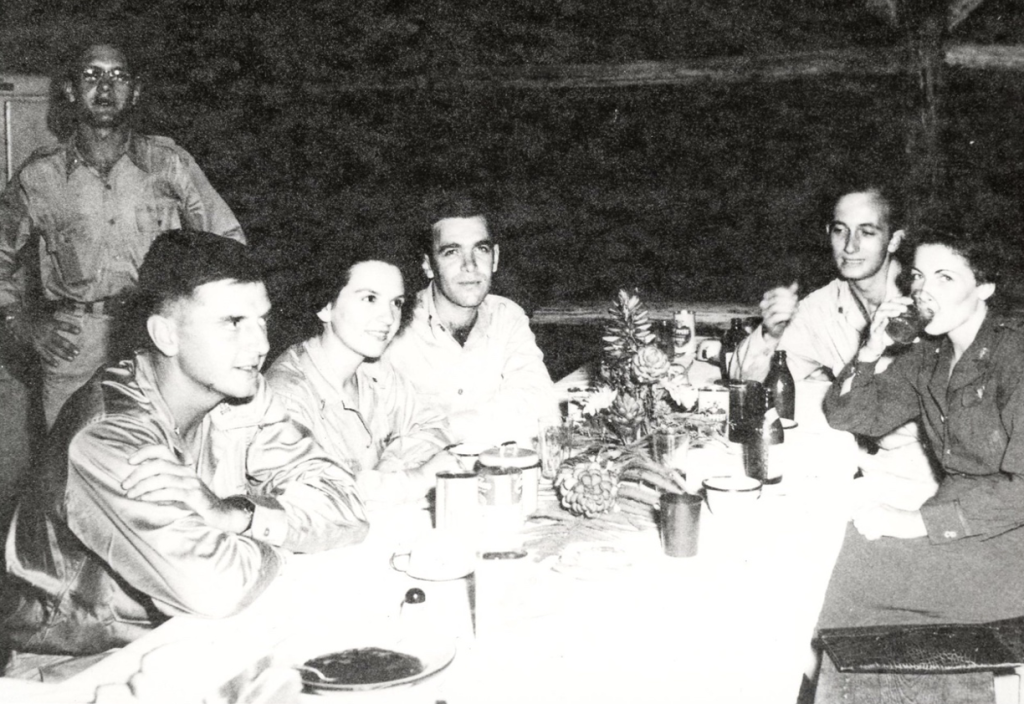
801 MAETS Helena Ilic (left) and Eloise Richardson
(right) Bougainville, 1943 (Author’s Collection)
Parties, Parties, and more Parties! August opened with so many invitations posted on our bulletin board [in Lido di Roma] that we could scarcely see what was going on in regards to our primary mission in Italy. In fact there were so very many entertainments that they seemed to lose their luster and we felt more than content to spend our evenings in our far from luxurious living room. 8
Thus wrote flight nurse Phoebe La Munyan whose flight nurses arrived on Temporary Duty at Lido di Roma in July 1944 to work with the 802 MAETS and 807 MAETS for Operation Dragoon. When the nurses of the 803 MAETS arrived in Calcutta, “The first few weeks seemed like a diplomatic convention with the rounds of invitations to dinners, dances, card parties, open houses and teas.” 9
When the arrangement of quarters permitted, the flight nurses often turned one of their rooms into a lounge, which was the site of formal receptions and dances giving the women opportunities to don evening dresses. “Our wearing of formals seemed even more appreciated than the punch,” wrote chief nurse June Sanders of the 819 MAETS about an open house that she and her colleagues hosted in April 1944 at Aldermaston in England. In December 1944 when the 817 MAETS was in Dreux, France, “the [flight] nurses inaugurated their new lounge with a dance which was thoroughly successful … and the Nurses [appeared] resplendent in their evening dresses”. 10
In gestures of appreciation, the flight nurses and flight surgeons in various MAES wined and dined their enlisted men with parties and dances given in their honor. On one such occasion the officers and nurses of the 803 MAETS put themselves on KP duty to the delight of their enlisted guests. 11
Sometimes the flight nurses – occasionally joined by the enlisted technicians – found simple yet pleasurable ways to fill long spells of inactivity when a steady schedule of flights was not forthcoming. Alice Krieble of the 818 MAETS in England remembered that both enlisted men and flight nurses would sit in a circle and crochet. To get the needed thread, they stripped the cords from parachutes no longer in use down to the finest thread while talking, telling jokes, and singing. “We’d all sing our hearts out hour after hour. If that isn’t good entertainment, I don’t know what is,” Krieble said. 12
Dorothy White Errair remembered similar activities with the 807 MAETS squadron in Sicily. She had purchased a violin, and when the flight nurses and enlisted technicians gathered around in the mess hall – the warmest place to spend the evening – writing letters and playing cards in the evenings, White would take out her violin and start playing, boosted by leftover hot coffee spiked with cognac. “[T]hey’d all sit and listen, and we’d all sit and sing. We’d have a ball. It was kind of innocent entertainment, but it did keep you busy.” White preferred it to dating:
Most of us had been injured or hurt romantically in the early stages of the war. My friend was missing – still is to this day missing. There was just never any word. And you learn then, you kind of shield yourself away from it. You’re just not going to get hurt again. So therefore, you have a lot of brothers. And it made for a much nicer arrangement. … Everybody is a friend. Nobody gets serious. … We did not get involved at the time, because if you liked somebody extra special, 9 chances out of 10, he was going to disappear. 13
The 805 MAETS flight nurses in Dorothy Vancil’s Flight were wined and dined as soon as they arrived “fresh from the States” in Accra (now Ghana) … “we were really rushed” as far as dates and dances.
Well, I’ll tell you, we finally stopped going to the dances, because it was just you were pulled from one pair of arms to another. You know, it wasn’t fun after a bit. They were almost rude. You felt like you were a piece of – you’re not a person. But there were so few women, and they wanted to dance with you. If they were going to ask the fellows, “May I dance?”, he would probably say, “No.” But they would just grab, you know. Oh! It got so that it was embarrassing, so we wouldn’t go to the dances after a bit. … We’d get our dates and stick to the 1 fellow. 14
But one social outing the flight nurses never turned down – dining with the Navy. Like their colleagues in other theaters of war, the 802 MAETS flight nurses in the Mediterranean never passed up an opportunity to dine on Navy ships docked in harbor, where meals were excellent and served in civilized splendor among great company. 15 The Navy had much better food than the Air Force,” chief nurse Elizabeth Pukas of the 812 MAETS in the Pacific explained.
And they were very gracious and very good to me. These were not rationed items for us, but I was able to get – because when we were in the islands, we had nothing but C-rations, the Navy, if we were grounded on any island any length of time, Navy personnel on a ship in the harbor were absolutely magnificent to us flight nurses. If we were there more than 5 days, we were invited aboard ship and given food. 16
Another 812 MAETS flight nurse confirmed this: “That was the best thing,” Nabors said, remembering the fresh fruit, vegetables, and meat. “We’d sell our soul,” they told their commander, “for an invitation to get over there and smell fresh–brewed coffee” after all the C–rations the flight nurses had to endure. Lee Holtz of the 801 MAES agreed. It did not matter who invited the flight nurses, they always went. “We’d go with anybody to get to eat a meal with the Navy. You got to that point.” 17
For more about the social life of the MAES flight nurses, see Beyond the Call of Duty: Army Flight Nursing in World War II. For more about flight nurses mentioned in this Blog, see Blogs posted for:
Dorothy White Errair 4 Jul 2016 and 24 Oct 2020
Ivalee (Lee) Holtz 30 Aug 2015 and 12 Jan 2020
Alice Krieble 20 Jul 2015 and 1 Dec 2019
Jo Nabors 20 Dec 2015 and 26 Apr 2020
Elizabeth Pukas 20 Sep 2015 and 2 Feb 2020
Dorothy Vancil Morgan 22 Feb 2016 and 28 Jun 2020
Audio recordings of these my interviews with these flight nurses are available at:
Dorothy Errair: https://www.iwm.org.uk/collections/item/object/80011347
Ivalee Holtz https://www.iwm.org.uk/collections/item/object/80011350
Jo Nabors https://www.iwm.org.uk/collections/item/object/80011354
Dorothy Morgan: https://www.iwm.org.uk/collections/item/object/80011351
Elizabeth Pukas https://www.iwm.org.uk/collections/item/object/80011355
Notes
- “Unit History January 1945”, 817 MAES, 5 Feb 1945.
- Nancy L. Preston and Ada MS. Endres, “The Feminine Side”, 801 MAETS, Aug 1944, 3–4. [AFHRA MED–801–HI]
- Dorothy Rice, letter to Lenore Stroop [Leora Stroup], 2 Feb 1944. [AMEDD]
- Elizabeth Pukas, interview with author, 9 Apr 1986.
- “History of Squadron Activities 1 September 1944 to 31 September 1944”, 820 MAETS, 12 Oct 1944, 63–64. [AFHRA MED–820–HI]
- Jo Nabors, interview with author, 1 May 1986.
- Wilbur A. Smith, “Historical Data, 1 June 1944 to 30 June 1944”, 801 MAETS, 3 Jul 1944, 3. [AFHRA MED–801–HI]
- Phoebe La Munyan, “Headquarters 819th Medical Air Evacuation Transport Squadron 31 August 1944 Squadron History”. [AFHRA MED–819–HI]
- “Life in India”, 803 MAETS. [AFHRA MED–803–HI]
- June Sanders, “Headquarters 819th Medical Air Evacuation Transport Squadron 30 April 1944 Squadron History Initial Issue”, 3–4; “Unit History December 1944”, 817 MAETS, 6 Jan 1945, 2.
- “803rd Activities for the Month of April 1944”.
- Alice Krieble, interview with author, 3 April 1986.
- Dorothy White Errair, interview with author, 24 May 1986.
- Dorothy Vancil Morgan, interview with author, 15 May 1986.
- Dorothy Lonergan “Scott Air Force Base 1942”, unpublished speech, n.d., 9–10. [AMEDD]
- Pukas, interview with author.
- Nabors, interview with author; Lee Holtz, interview with author, 4 Apr 1986.

